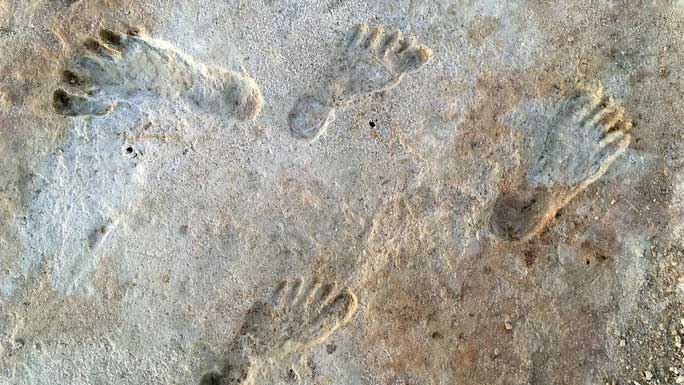Surprising fossil tracks have been uncovered at White Sands National Park (New Mexico, USA), recognized as the oldest human footprints in North America.
According to Live Science, a new study employed two dating techniques simultaneously to date the fossils that had been controversial back in 2021.
Both methods indicated that the footprints at White Sands are 21,000 to 23,000 years old, dating back to the Late Pleistocene Epoch (26,500 to 19,000 years ago), which was the coldest period of the last Ice Age.
This new discovery has pushed back the timeline for when humans first explored North America by as much as 10,000 years.

Ancient footprints at White Sands National Park – (Photo: NATIONAL PARK SERVICE).
The previous record was held by the Clovis people, whose sharp-edged stone tools indicated they inhabited the Americas from 13,000 years ago.
Previously, the research team—led by Dr. Jeffrey Pigati and Dr. Kathleen Springer from the United States Geological Survey (USGS)—published a study in 2021, determining when humans first arrived in North America based on the analysis of radiocarbon isotopes from Ruppia cirrhosa.
This is an aquatic plant buried within the ancient footprints.
Some scientists criticized these results. Notably, anthropologist Professor Loren Davis from Oregon State University argued that the isotopes used for dating—carbon-14—could have been absorbed by plants from lake water. This means they could draw in older carbon isotopes from sediments rather than being accurate to their own age.
Professor Davis suggested the research team try dating methods using Optically Stimulated Luminescence (OSL), which estimates the last time quartz or feldspar grains in sediments were exposed to sunlight or high temperatures.
In the recently published study in the journal Nature, the USGS team applied this OSL technique. The results indicated an age of 21,500 years.
Additionally, they isolated and dated three soil samples through radiocarbon isotopes, each containing 75,000 conifer pollen grains from the footprint layers.
The conifer trees acquire carbon-14 from the atmosphere, meaning they cannot be confused with ancient carbon in water like Ruppia grains.
The results from this second method indicated a remarkable timeframe: 23,000 years.


















































